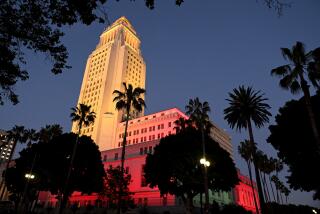Hermosa Voters Will Try Again on Biltmore Parcel
Stumped and divided, the Hermosa Beach City Council agreed Tuesday to give voters yet another chance to solve two of the city’s most vexing problems: what to do about the increasingly “bulky” and closed-in feel of the community and what to put on the site of the old Biltmore hotel.
Four ballot measures--three dealing with density and building heights and a fourth on the Biltmore site-- will appear on the Nov. 5 ballot.
The density questions include two advisory measures designed to help the council set policy on housing development standards and a third, binding question asking whether the city should lower commercial building heights.
The Biltmore question will ask voters whether they want a mixture of houses, businesses and parkland on the .82-acre site. Competing with it will be a separate citizen’s initiative calling for a park on the beachfront lot.
The two problems, density and the Biltmore site, are among the oldest in the community, and council after council has sought in a vain to satisfy a majority of the city’s voters.
Density has been discussed in Hermosa Beach almost since the city sprang up as a summer resort, when cottages began popping up on 30-by-90-foot lots described by one old-timer as “too small to live on and too big to die on.”
As the lots were developed, the cottages began to get taller and taller as residents sought to capture the ocean view--a view that steadily diminished as more of those cottages went up along the beach.
The building height issue proved no more tractable this year, and at Tuesday’s meeting homeowners balked at the council’s solution.
Council members proposed this spring that the city vote on lowering the roofs of multifamily homes and those in the commercial districts along Artesia and Aviation boulevards and Pacific Coast Highway.
Depending on the zone, multifamily homes in Hermosa Beach can be up to 35 feet high, and commercial buildings up to 45 feet. The council sought to limit multifamily homes to 25-30 feet, depending on the zone, and commercial buildings to 30-35 feet.
But even putting the issue of residential height restrictions up for a vote was flash point Tuesday.
“One hundred percent of my neighbors have built to 35 feet--in front of me, behind me and on both sides--and now I’m being told I can only go to 25 feet?” said homeowner Dane Shaw. “That’s a load of rot.”
No speaker favored the residential limits. And several, including former Planning Commissioner Jerry Compton, criticized the council for indulging in “ballot box planning” in an attempt to escape political heat. If the council favored controlling density, it ought to go through the planning process and then be held accountable, he said.
Councilmen Chuck Sheldon and Albert Wiemans agreed with that assessment and ultimately voted against putting any density measures on the ballot. Both councilmen contended the issue is too complex to be explained in a brief ballot argument, and said calling for a vote is a waste of money.
After more than an hour of public testimony, however, the council majority compromised, agreeing to put only the commercial building heights on the ballot. The residential heights, they decided, should be dealt with in an advisory vote, asking whether the council should consider lowering building heights in all residential zones.
In a second advisory question, voters will be asked whether development standards, overall, should be tightened to “reduce bulk.” The question would help the council get a feel for the voters’ feelings on a variety of zoning issues, ranging from setbacks to parking requirements to lot coverage.
The Biltmore issue, meanwhile, has dogged the community for more than 20 years, since the city razed the old Biltmore Hotel on the 1400 block of The Strand. Although the site is no more than a tiny and littered vacant lot, it is one of the last undeveloped beachfront stretches in the 1.3-square-mile town, and the community has been at an impasse for years over how best to use it.
Ten times in recent years, voters have been asked what to do with the site. But no option--houses, businesses, open space or any combination thereof-- has managed to win a majority vote.
Open space proponents believe the community would be best served by turning the site into a park. Adherents of the other two options argue a better solution would be to sell the land for beachfront houses and businesses, and use the money to improve existing parks and to buy larger blocks of open space inland; that way, they say, residents would have neighborhood parks to themselves, rather than having to share them with the masses who flock each summer to the local beach.
Earlier this year, the council tried again to settle the fate of the Biltmore site, pitching a plan to sell the site for homes and use the proceeds--about $7 million--to buy land elsewhere in the city.
But the state Coastal Commission, whose approval is necessary for any development of the site, voted against the plan in March, charging that the plan impeded public access to the beach. The commission insisted that 30% of the lot be set aside for businesses that would serve beach-goers, such as food concessions, restaurants or skate rental shops.
The council’s 4-1 decision Tuesday--with Wiemans voting no-- would place on the ballot the Coastal Commission’s plan, calling for houses on the southern 70% of the lot, businesses--preferably an upscale restaurant--in the area’s northeast corner and a small, tree studded plaza in the corner of the site at The Strand and 14th Street.
Voters who dislike that plan could vote instead for a competing citizens’ initiative that would turn the entire area into a beachfront park.
More to Read
Sign up for Essential California
The most important California stories and recommendations in your inbox every morning.
You may occasionally receive promotional content from the Los Angeles Times.










